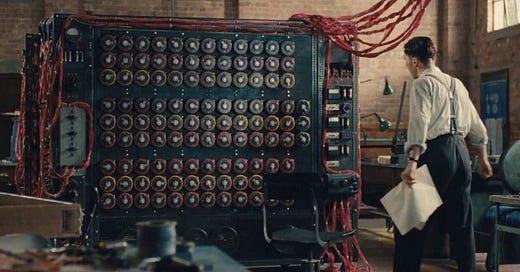The Imitation Game: A Genius, a War, and the Secrets of Codebreaking
If you enjoy historical dramas, war stories, or tales of brilliant minds, The Imitation Game is a movie worth watching. But even if you’re not into these topics, the film still has a way of drawing you in—because at its heart, it’s not just about cracking codes. It’s about one man’s fight against time, society, and ultimately, himself.
A War Fought with Numbers
During World War II, the Nazis used a complex encryption system called the Enigma Machine to protect their military communications. The code was so advanced that it changed daily, making it virtually impossible for the Allies to decipher their messages. With over 159 quintillion possible combinations, breaking Enigma through traditional methods would have taken longer than the war itself.
This is where Alan Turing (played by Benedict Cumberbatch) enters the story. A brilliant but socially awkward mathematician, Turing was recruited by the British government to join a secret team of codebreakers at Bletchley Park. But instead of trying to break the code manually like his colleagues, Turing had a radical idea—build a machine that could do the work for them. This machine, which he named Christopher, would later evolve into one of the first modern computers.
Of course, no one believed in his idea at first. His superiors dismissed him, his teammates found him unbearable, and his funding was almost cut. But with determination, and a little help from Joan Clarke (Keira Knightley), one of the few women in the field, Turing’s invention worked. The machine cracked Enigma, giving the Allies access to German military secrets and helping end the war years earlier than expected.
More Than Just a Puzzle
While the movie focuses on codebreaking, it’s also a deeply personal story. Turing wasn’t just battling an enemy encryption system—he was also struggling with his own place in society. He had a hard time connecting with people, often coming across as arrogant or insensitive. His only true friend was Joan, who not only saw his genius but also respected him as a person.
But there was another secret Turing had to keep hidden: he was gay. In 1940s Britain, homosexuality was illegal, and being outed could destroy a person’s career—and life. Although the film touches on this aspect of his life, it doesn’t dwell on it too much. It’s more of a tragic footnote, something that reminds us that even though he helped save millions of lives, society still refused to accept him.
After the war, instead of being celebrated as a hero, Turing was prosecuted for “indecency”. His punishment? Chemical castration—a horrifying medical treatment that left him physically and mentally broken. Just two years later, he was found dead from cyanide poisoning, in what is widely believed to have been suicide.
The Hidden Language of Codes
The world of encryption didn’t stop with Enigma. Another famous system that played a huge role during wartime was Morse code—a method of sending messages through dots and dashes. While Enigma was used for heavily coded military strategies, Morse code was often used for simpler, urgent messages, especially by spies and radio operators.
Today, Morse code translators make it easy to convert text into Morse signals—type "HELLO" and it turns into ".... . .-.. .-.. ---". While it’s no longer a top-secret tool of war, it’s still used in emergency communications and even as a fun puzzle for cryptography enthusiasts. The same principles behind Morse code—substituting symbols for letters—are at the heart of all modern encryption systems.
If you enjoyed the puzzle-solving elements in The Imitation Game, trying out a Morse code translator or experimenting with classic ciphers like the Caesar cipher or Vigenère cipher might be a fun way to experience a bit of that history yourself.
Is It Worth Watching?
The Imitation Game is a well-crafted, emotional, and thought-provoking film. It’s one of those movies that makes history feel alive, turning what could have been a dry retelling of war-time mathematics into something gripping and human.
That being said, the film does take creative liberties. The real Alan Turing wasn’t quite as cold and socially inept as the movie portrays. He had friendships, relationships, and wasn’t the complete outsider the film makes him out to be. But Hollywood loves a tortured genius, so it leans into that trope to make the story more dramatic.
Still, the film does an important job: it brings attention to a man who was once forgotten by history. Without Turing, modern computers might not exist as we know them today. His contributions were immense, yet he suffered unjustly for simply being himself.




